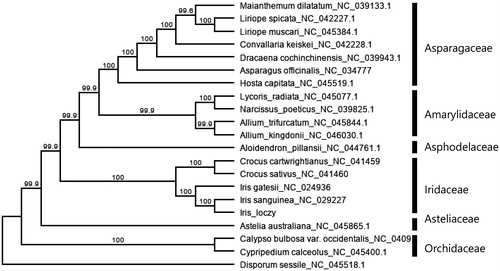Abstract
Iris loczyi is a perennial rhizomatous herb distributed in Central Asia. We examined genomic architecture of the complete chloroplast genome in I. loczyi by assembling the Illumina MiSeq reads using de novo strategy. The chloroplast genome is 150,940 bp in length harboring 79 protein-coding genes, 30 tRNA genes, and four rRNA genes. It exhibits typical quadripartite structure comprising LSC (80,907 bp), SSC (17,853 bp), and a pair of IRs (26,090 bp). Phylogenetic analysis of 20 chloroplast genomes from Asparagales revealed that Iridaceae is a monophyletic group and the I. loczyi is clustered together with the congener, I. sanguinea.
Iris loczyi Kanitz (Iridaceae), is a rhizomatous perennial herb distributed in Central Asia including Afghanistan, Iran, Kazakhstan, Kyrgyzstan, Pakistan, Tadzhikistan, Uzbekistan (Khassanov and Rakhimova Citation2012). Like most plants in Iris L., I. loczyi is a well- recognized plant for its economical values in pharmaceutical and horticultural practices (Crisan and Cantor Citation2016). The plant has recently drawn much attention as it contains various secondary metabolites that might have the potential to manage diabetes (Mosihuzzman et al. Citation2013). However, the genomic information applicable for breeding program and other biological studies is scarce. In the present study, we investigated the genomic architecture in the whole chloroplast genome of I. loczyi using whole genome shotgun sequencing.
We collected young leaves of I. loczyi from Issyk kul, Kyrgyzstan (N42°47’0.8″, E77°31′41.9″). The voucher specimen was prepared and deposited at the Herbarium of Korea National Arboretum (KH) with the accession number KHB1544459. The total genomic DNA was extracted followed by manufacturer’s protocol (Quiagen, Hilden, Germany). After library preparation, the prepared libraries were sequenced on Illumina MiSeq platform (Illumina, San Diego, CA). Eight million high-quality 300 bp paired-end reads were obtained. We assembled 2.85 GB reads with de novo strategy using CLC Assembly Cell package (ver. 4.2.1) followed by Kim et al. (Citation2015). The genes were predicted with GeSeq (Tillich et al. Citation2017) and manually curated based on Blast search result. The simple sequence repeats were investigated with MISA (Beier et al. Citation2017).
The complete chloroplast genome of I. loczyi (MT254070) is 150,940 bp in length with the typical quadripartite structure comprising LSC (80,907 bp), SSC (17,853 bp), and a pair of IRs (26,090 bp). The cp genome contained 113 genes including 79 protein-coding genes, 30 tRNA genes, and four rRNA genes. 463 simple sequence repeats were identified in the cp genome, most of which was penta-nucleotide.
To investigate its phylogenetic relationship, the entire chloroplast genome sequences of 20 Asparagales taxa were aligned in MAFT (Katoh et al. Citation2019). All sequences other than I. loczyi were downloaded from NCBI Genebank. We assigned Disporum sessile D.Don (Colchicaceae) as an outgroup following phylogenetic relationships based on APG system (Stevens Citation2017). We inferred the phylogeny using Maximum-likelihood algorithm implemented in RAxML v. 4.0 with GTR GAMMA model. For the clade support, 1000 bootstrap replicates were used. The five species of Iridaceae formed a monophyletic group (BP = 100) with strong support on ML tree (). In ML tree, Iridaceae grouped together with Asparagaceae, Amarylidaceae and Asphodelaceae, while Orchidaceae and Asteliaceae formed separate clades respectively. The ML tree also indicated that I. loczyi is closely related with I. sanguinea which is consistent with the previous subgeneric classification (Wilson Citation2004).
Disclosure statement
The authors report no conflict of interest. The authors alone are responsible for the content and writing of the paper.
Data availability statement
The data that support the findings of this study are openly available in NCBI GenBank at https://www.ncbi.nlm.nih.gov/genbank/, accession number MT254070.
Additional information
Funding
References
- Beier S, Thiel T, Münch T, Scholz U, Mascher M. 2017. MISA-web: a web server for microsatellite prediction. Bioinformatics. 33(16):2583–2585.
- Crisan I, Cantor M. 2016. New perspectives on medicinal properties and uses of Iris sp. Hop Med Plants. 24:24–36.
- Katoh K, Rozewicki J, Yamada KD. 2019. MAFFT online service: multiple sequence alignment, interactive sequence choice and visualization. Brief Bioinformatics. 20(4):1160–1166.
- Khassanov FO, Rakhimova N. 2012. Taxonomic revision of the genus Iris L. (Iridaceae Juss.) for the flora of Central Asia. Stapfia. 97:174–179.
- Kim K, Lee SC, Lee J, Lee HO, Joh HJ, Kim NH, Park HS, Yang TJ. 2015. Comprehensive survey of genetic diversity in chloroplast genomes and 45S nrDNAs within Panax ginseng species. PLoS One. 10(6):e0117159.
- Mosihuzzman M, Naheed S, Hareem S, Talib S, Abbas G, Khan SN, Choudhary MI, Sener B, Tareen RB, Israr M. 2013. Studies on α-glucosidase inhibition and anti-glycation potential of Iris loczyi and Iris unguicularis. Life Sci. 92(3):187–192.
- Stevens PF. 2017. Angiosperm Phylogeny Website. Version 14.
- Tillich M, Lehwark P, Pellizzer T, Ulbricht-Jones ES, Fischer A, Bock R, Greiner S. 2017. GeSeq - versatile and accurate annotation of organelle genomes. Nucleic Acids Res. 45(W1):W6–W11.
- Wilson CA. 2004. Phylogeny of Iris based on chloroplast matK gene and trnK intron sequence data. Mol Phylogenet Evol. 33(2):402–412.

